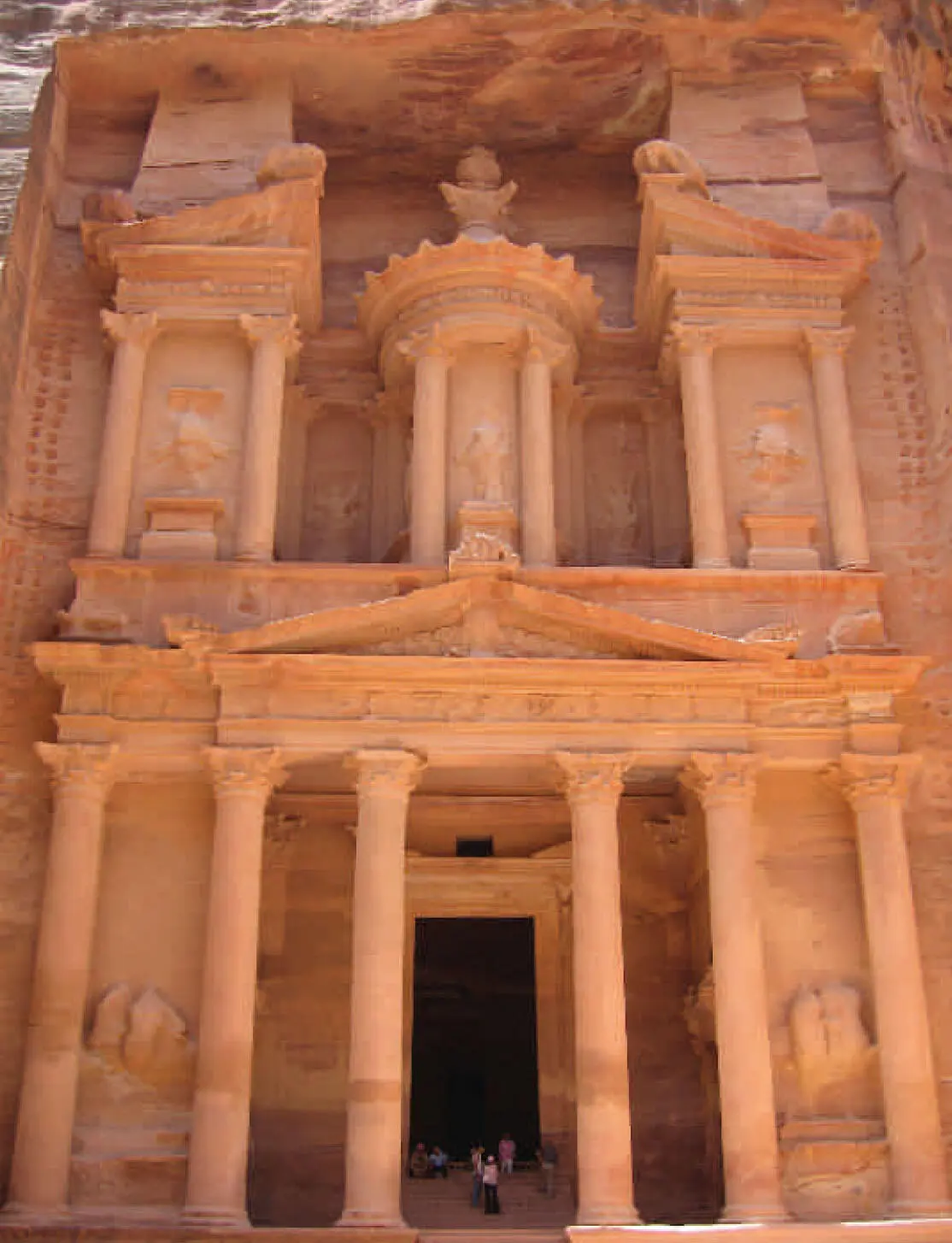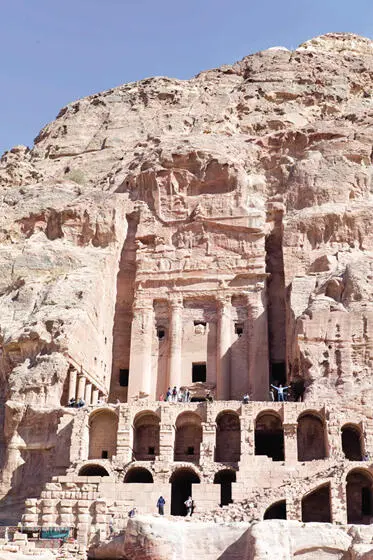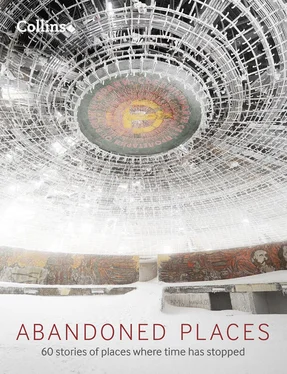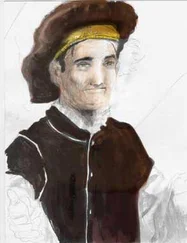The Nabataeans thought differently, and they built an ingenious system of conduits, dams, cisterns and pipes to channel and store the rain and spring water from a wide area. This vast plumbing network turned a meagre 15 cm (6 inches) of annual precipitation into a constant water supply that could deliver an estimated 12 million gallons of fresh water a day. In effect, they had created an artificial oasis. Its water supported the people of Petra – and was vital to travellers, which helped make the city rich.

The façade of Al Khazneh (‘The Treasury’) is 40 m (131 ft) high. Its position deep in a gorge has helped protect it from erosion.

The Urn Tomb, first of the Royal Tombs, is built high up on the mountain side.
Petra was located at the junction of a trade route to Asia and another to Arabia. These were the motorways of their day, along which caravans of 2,500 camels, up to 8 km (5 miles) in length, carried spices, cloth, ivory, metals and incense such as frankincense and myrrh. Petra was an ideal rest and refreshment point for these travellers and, as with any service station, the Nabataeans ensured they profited from their visitors.
By 100 BC the Nabataeans had control of the spice trade and they used their burgeoning wealth to expand their remarkable city. Petra became a metropolis of temples, monuments, altars, houses, and banquet halls carved into the sandstone cliffs. There are 3,000 carved tombs and the open-air theatre could seat 8,000 people.
Like all empires, the Nabataean dynasty eventually had its fall. Petra was taken within the arms of the Roman Empire in AD 106 and at first flourished in the relationship; the city was at the height of its wealth and influence around AD 200. However, the city of Palmyra gradually drew Arabian trade away from Petra, which declined as a trading hub.
In AD 363 there was a cataclysmic earthquake that cracked beautifully carved facades, brought rocks tumbling from walls and fractured the seats in the theatre. Although people continued to live here, the city never fully recovered from this shock.
By the fifth century the Nabataeans had converted from their own faith to Christianity and Petra became a renowned religious settlement within the Byzantine realm. But by AD 663 even the pilgrims had ceased to come and the city was deserted.
The city slept in its desert canyon for nearly a millennium, forgotten by the wider world. It was rediscovered by an adventurous 27-year-old Swiss traveller, Johann Ludwig Burckhardt, in 1812. He spent years learning fluent Arabic and had disguised himself as a Bedouin to explore as far off the beaten track as possible. Tales of the lost city’s mystical beauty captured the Victorian imagination, and it was famously described as ‘a rose-red city half as old as time’ in a poem by John William Burgon.
In the First World War, Petra was at the centre of an Arabian revolt against the Ottoman regime. British Army officer T. E. Lawrence, better known as Lawrence of Arabia, helped drum up support amongst the Bedouins living in the area to rout the Turkish forces.

The Treasury by night. Behind the facade is a large square room; Indiana Jones found the Holy Grail inside.
Few cities on earth have as spectacular an entrance as Petra. It is approached through the Siq, a sinuous gorge that snakes for 1.2 km (0.75 miles) between gloomy cliffs up to 182 m (597 ft) high. In some places the Siq (meaning ‘the Shaft’) is only 3 m (9.8 ft) wide, but this split in the mountain is the main way of accessing the city.
Visitors pad through the sandy darkness to finally emerge in a blinding cathedral of light and come face to face with one of Petra’s most famous monuments: Al Khazneh (‘The Treasury’). This was not a place of business, but rather a crypt built around the time of Christ. It later got its name from a story about bandits who had hidden gold in one of the urns carved high on the facade. Today this urn is pocked with bullet holes made by Bedouins trying to shatter it and release the treasure. In fact, the urn is solid sandstone. The Treasury’s huge pillars and pediment are of Greek influence in their design, like many of the buildings in Petra.
Another spectacular carved building is the monastery (actually a temple), which is cut into a hilltop an hour’s climb from the main city. The scale of the stone-carving here is truly awe-inspiring: the monastery’s huge facade is 50 m (165 ft) square and its doorway is as tall as most houses.
Cut into Petra’s East Cliff are the Royal Tombs, a group of large and impressive facades. In the warm ruby light of late afternoon the whole cliff here seems to shimmer and glow.
The secrets that sleep on
Film lovers will be aware of Petra’s starring role in many motion pictures. These appearances, and its regular inclusion in new ‘Wonders of the World’ lists, have widened its fame and made it one of the best known abandoned places. Today, Petra is the most visited place in Jordan and a UNESCO World Heritage Site.
However, one of the most intriguing things about Petra is how much more of it is yet to be discovered. Only 15 per cent of the city has been explored by archaeologists; the vast majority remains underground and untouched, as it has been since antiquity.
DATE ABANDONED: Sixteenth century
TYPE OF PLACE: Inca city
LOCATION: Peru
REASON: Disease/Invasion
INHABITANTS: c. 1,000
CURRENT STATUS: UNESCO World Heritage Site
CROWNING A SHEER-SIDED PERUVIAN MOUNTAIN IS MACHU PICCHU, AN EXTRAORDINARY EXPRESSION OF ENGINEERING SKILL AND RELIGIOUS DEVOTION THAT WAS ABANDONED ONLY 100 YEARS AFTER ITS CONSTRUCTION. THE INVADING SPANISH NEVER FOUND THE CITY, BUT THE DESTRUCTION THEY BROUGHT KILLED IT NONETHELESS.

It was a royal Inca estate and religious retreat that just happened to be perched on a precipitous mountain ridge at 2,430 m (7,970 ft) above sea level. Machu Picchu was completed around 1450, and flourished as a self-sustaining stronghold of 1,000 souls for 100 years. Then it was abruptly abandoned during a time of catastrophic population collapse. Today its enigmatic remains are among the most beautiful and spectacular of all lost civilizations.
It’s hard to imagine a site with better natural defensive protection. The Urubamba River encircles the site on three sides, at the bottom of cliffs that drop vertically for 450 m (1,480 ft). On the fourth side is a nearly impassable mountain peak.
There was a secret entrance via rope bridge, known only to the Inca army. If an offensive army were to approach they would be seen miles away. When they arrived they would have an unpleasant climb up a near-sheer, heavily vegetated cliff face. Any attempt to starve out the inhabitants would be doomed to failure – the city had enough arable land within its walls to feed its population four times over, and fresh water is not a problem in this misty, rainy area.
Читать дальше
















